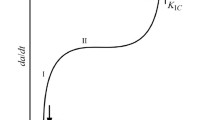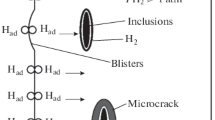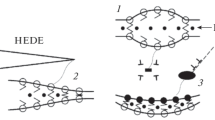Abstract
A “hydrogen partitioning” model has been developed to account for the pressure and temperature dependence for hydrogen-assisted crack growth. The model gives explicit recognition to the role of hydr en-microstructure interactions in determining the distribution (or partitioning) of hydrogen among the various microstructural elements (principally between the prior-austenite grain boundaries and the matrix) and the rate of crack growth along the elements. It also takes into account the role of various rate controlling processes in determining the rate that hydrogen is being supplied to the fracture process (or embrittlement) zone. Quantitative assessment of the model indicates very good agreements between the model predictions and the observed crack growth responses for AISI 4340 and 4130 steels tested in hydrogen and for AISI 4340 steel tested in hydrogen sulfide. This model accurately characterizes the reduction in crack growth rate and the concomitant change in fracture mode at “high” temperatures. Through its integration with the earlier models, based on rate controlling processes, the model predicts the pressure and temperature dependence for K-independent crack growth over the entire range of environmental conditions.
Similar content being viewed by others
References
D. P. Williams and H. G. Nelson:Metall. Trans., 1970, vol. 1, p. 63.
H. G. Nelson, D. P. Williams, and A. S. Tetelman:Metall. Trans., 1971, vol. 2, p. 953.
H. G. Nelson and D. P. Williams: inStress Corrosion Cracking and Hydrogen Embrittlement of Iron Base Alloys, R. W. Staehle, J. Hochmann, R. D. McCright, and J. E. Slater, eds., NACE-5, Houston, TX, 1978, p. 390.
R. P. Gangloff and R. P. Wei:Metall. Trans. A, 1977, vol. 8A, p. 1043.
R. P. Gangloff and R. P. Wei: ASTM STP 645, American Society for Testing and Materials, Philadelphia, PA, 1978, p. 87.
G. W. Simmons, P.S. Pao, and R.P. Wei:Metall. Trans. A, 1978, vol. 9A, p. 1147.
M. C. Lu, P. S. Pao, N. H. Chan, K. Klier, and R. P. Wei: in Pro- ceedings of Second Japan Institute of Metals International Symposium (JIMIS-2), Hydrogen in Metals, Suppl. to Trans. Japan Inst. Metals, 1980, vol. 21, p. 449.
N. H. Chan, K. Klier, and R. P. Wei: in Proceedings of Second Japan Institute of Metals International Symposium (JIMIS-2), Hydrogen in Metals, Suppl. to Trans. Japan Inst. Metals, 1980, vol. 21, p. 305.
M. C. Lu, P. S. Pao, T. W. Weir, G. W. Simmons, and R.P. Wei:Metall. Trans. A, 1980, vol. 12A, p. 805.
R. P. Wei, K. Klier, G. W. Simmons, and Y. T. Chou: inHydrogen Embrittlement and Stress Corrosion Cracking, R. Gibala and R. F. Hehemann, eds., American Society for Metals, Metals Park, OH, 1984, p. 103.
R. P. Wei: inHydrogen Effects in Metals, I. M. Bernstein and A. W. Thompson, eds., TMS-AIME, Warrendale, PA, 1981, p. 677.
H. G. Nelson: NASA TN D-6691, National Aeronautic and Space Administration, 1972.
R. W. Pasco and P. J. Ficalora:Scripta Met., 1980, vol. 15, p. 1019.
R. W. Pasco, K. Sieradzki, and P. J. Ficalora:Scripta Met., 1982, vol. 16, p. 881.
J. A. Schwarz and H. W. Liu:Scripta Met., 1980, vol. 15, p. 839.
Ming Gao, M. Lu, and R. P. Wei:Metall. Trans. A, 1984, vol. 15A, p. 735.
Ming Gao: M. S. Thesis, Lehigh University, Bethlehem, PA, 1982.
A. J. Stavros and H. W. Paxton:Metall. Trans., 1970, vol. 1, p. 3049.
G. Lapasset, J. P. Laurent, M. Aucouturier, and P. Lacombe: inl’Hy- drogen dans les Mètaux Congrès International, Editions Science et Industrie, Paris, 1972, p. 108.
Vassel, G. Lapasset, J. P. Laurent, M. Aucouturier, and P. Locombe:, p. 348.
T. Asaoka, G. Lapasset, M. Aucouturier, and P. Lacombe:Corrosion, 1978, vol. 34, p. 39.
A. H. Cottrell: inDislocation and Plastic Flow in Crystals, Oxford Press, Amen House, London, 1965.
J. P. Hirth:Metall. Trans. A, 1980, vol. 11A, p. 861.
J. O’M. Bockris: inStress Corrosion Cracking and Hydrogen Em- brittlement of Iron Base Alloys, R. W. Staehle, J. Hochmann, R. D. McCright, and J. E. Slater, eds., NACE-5, Houston, TX, 1978, p. 286.
Ming Gao: Ph.D. Thesis, Lehigh University, Bethlehem, PA, 1983.
T. W. Weir, G. W. Simmons, R. G. Hart, and R. P. Wei:Scripta Met., 1980, vol. 14, p. 357.
S. Glasstone, K. J. Laidler, and H. Eyring: in The Theory of Rate Processes, McGraw-Hill, 1948, p. 339.
M. C. Lu, Y. T. Chou, and R. P. Wei: unpublished research, Lehigh University, Bethlehem, PA, 1980.
G. M. Pressouyre and I. M. Bernstein:Metall. Trans. A, 1978, vol. 9A, p. 1571.
R. Gibala and D. S. DeMegli: inHydrogen Effects in Metals, I. M. Bernstein and A. W. Thompson, eds., ASM, Metals Park, OH, 1981, p. 113.
R. Gibala: inStress Corrosion Cracking and Hydrogen Embrittlement of Iron Base Alloys, R.W. Staehle, J. Hochmann, R. D. McCright, and J. E. Slater, eds., NACE-5, Houston, TX, 1978, p. 244.
A. P. Miodownik:, p. 272.
P. S. Pao and R. P. Wei:Scripta Met., 1971, vol. 11, p. 515.
N. H. Chan, K. Klier, and R. P. Wei:Scripta Met., 1978, vol. 12, p. 1043.
Author information
Authors and Affiliations
Rights and permissions
About this article
Cite this article
Gao, M., Wei, R.P. A “Hydrogen partitioning” model for hydrogen assisted crack growth. Metall Trans A 16, 2039–2050 (1985). https://doi.org/10.1007/BF02662405
Received:
Issue Date:
DOI: https://doi.org/10.1007/BF02662405




